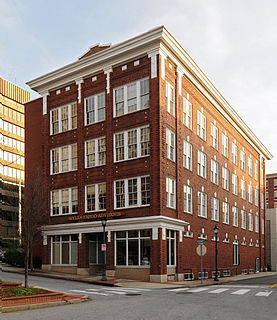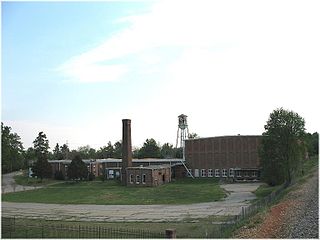
The Piquette Avenue Industrial Historic District is a historic district located along Piquette Street in Detroit, Michigan, from Woodward Avenue on the west to Hastings Street on the east. The district extends approximately one block south of Piquette to Harper, and one block north to the Grand Trunk Western Railroad Line. It was listed on the National Register of Historic Places in 2004.

The Junction Shop and Hermon Street District is a historic district comprising 28 industrial properties on Jackson, Hermon, and Beacon Streets on the south side of Worcester, Massachusetts. It is a remnant of a once larger 19th and early 20th century manufacturing district just west of the railway junction between the Boston and Maine Railroad and the New York, New Haven and Hartford Railroad. It was listed on the National Register of Historic Places in 1980.

Confederate Printing Plant is a historic industrial building located at Columbia, South Carolina. It was built in 1864, and is a large two-story, Greek Revival style brick structure. Originally it was a one-story structure, but enlarged to two-stories after the building was burned in February 1865 by General William Tecumseh Sherman’s army. It was built by the Evans and Cogswell Company for the manufacture of Confederate bonds and other printing purposes. During the 20th century, it was used as a liquor warehouse by the South Carolina Dispensary and is presently used as a Publix grocery store and residential condominiums.

Southern Cotton Oil Company, also known as Columbia Mill, was a historic cottonseed oil complex located at Columbia, South Carolina. The complex was built between 1887 and 1919. It consisted of seven industrial buildings: the Seed House, Linter Room, Press Room, Machine Shop, Oil House, Cotton Storage Room, and Storage Shed. Five of the buildings were constructed of brick and the other two were constructed of galvanized sheet metal. The complex has been demolished.

Olympia Mill, also known as Pacific Mill, is a historic textile mill complex located at Columbia, South Carolina. It was built in 1899, and consists of a four-story, red brick, rectangular shaped, main mill building connected to a one and two-story red brick power plant. The main building is in the Romanesque Revival style and features terra cotta detailing, large segmental arched window openings, and twin pyramidal roofed towers. The complex also includes: a one-story brick power plant auxiliary building, a one-story storage building, and two small brick one-story gatehouses.

Pacific Community Association Building, also known as Pacific Community YMCA and The 'Y', is a historic community center located at Columbia, South Carolina. The original section was built in 1903, and is a large two-story, irregularly-shaped brick building. It was enlarged around 1918 with the addition of the pool building, and a large gymnasium in 1923. It provided recreational opportunities for residents of mill villages associated with the Olympia and Granby Mill complex.

Pacolet Mill Office, also known as Pacolet Municipal Building and Town Hall, is a historic office building located at Pacolet, Spartanburg County, South Carolina. It built in 1908 by the Pacolet Manufacturing Company. It is a one-story, brick building with full-height basement level. It has a low-pitched hip roof with flared eaves and decorative exposed rafter tails. The roof is clad with clay Spanish tile. The site features a curving cast stone or concrete pergola added some time between 1920 and 1927. In 2004, the building became the town hall for the Town of Pacolet.

Ebenezer Academy is a historic school building located at Rock Hill, South Carolina. It was built about 1860, and is a one-story, rectangular brick structure of simple design. The school was originally associated with Ebenezer Presbyterian Church until Rock Hill public schools were established about 1888 and was leased to York County for an elementary school. The school continued until 1950 when it was deeded back to the church. It is the oldest known school building standing in York County.

Tillman Hall, originally known as Main Building, is a historic academic building located on the campus of Winthrop University at Rock Hill, South Carolina. It was built in 1894, and is a three-story, red brick building in the Richardsonian Romanesque style. The building includes a basement and attic, has a combination gabled and hipped roof configuration, projecting bay windows, and features a conical-roofed clock tower with open belfry. In 1962, Main Building was renamed Tillman Hall for Governor, Democratic U.S. Senator, and avowed white supremacist Benjamin Tillman. Tillman Hall's Auditorium has hosted concerts by Frankie Valli and the Four Seasons in 1970, Jars of Clay in 1997, Florida's metal band Trivium in 2005, Celtic rock band Seven Nations in 2005, Recycled Percussion in 2007, and pop folk pianist Vienna Teng in 2008. The 2008 direct-to-video horror film Asylum was filmed outside of and inside Tillman Hall. The ending of the 1999 horror film Carrie 2 was filmed at Tillman Hall.

Afro-American Insurance Company Building is a historic commercial building located at Rock Hill, South Carolina. It was built about 1909, and is a two-story, brick commercial building. The façade has a tan brick veneer, while the sides and rear are in red brick. It is an important surviving example of a commercial building related to the African-American community of the early-20th century.

People's National Bank Building, also known as Franklin's Clothing Store, is a historic bank building located at Rock Hill, South Carolina. It was built about 1909–1910, and is a four-story brick building, plus basement. It was the first building in the city constructed as a speculative office building, the first with a passenger elevator, and the tallest commercial building in Rock Hill. The People's National Bank merged with Citizens and Southern National Bank of South Carolina in 1964 and moved out of the building in 1972.

Rock Hill Cotton Factory, also known as Plej's Textile Mill Outlets, Ostrow Textile Mill, and Fewell Cotton Warehouse, is a historic textile mill complex located at Rock Hill, South Carolina. The mill was built in 1881, and is a two-story, 12 bay by 16 bay, brick factory. It features a three-story tower at the main entrance. A number of additions have been made to the building. The Fewell Cotton Warehouse is a one-story, brick and wood frame warehouse built before 1894.

Bleachery Water Treatment Plant is a historic water treatment plant located at Rock Hill, South Carolina. It was built in 1930, and is a one-story brick building and filtration/purification facility in the Colonial Revival style. The city of Rock Hill passed a bond issue to build Bleachery Water Treatment Plant, to support the Rock Hill Printing and Finishing Company investment by M. Lowenstein Company of New York.

Highland Park Manufacturing Plant and Cotton Oil Complex is a historic industrial complex and national historic district located at Rock Hill, South Carolina. It encompasses three contributing building and two contributing structures in Rock Hill. The complex includes the Highland Park Manufacturing Plant, the Highland Park Cotton Oil Mill (1902), and the Highland Park Cotton Oil Mill Office (1902). They are the surviving buildings of a larger complex, including a gin and seed house, the rest of which have been demolished. Surrounding the original mill are portions of the mill village. The mill operated until 1968.

Carolina Supply Company is a historic commercial building located at Greenville, South Carolina. It was built in 1914, and is a four-story, brick building in a utilitarian Renaissance Revival style. The building housed a textile and industrial supply company that supplied mills with equipment and supplies. The building now houses Wells Fargo Bank.

Sterling Cotton Mill, also known as the Franklinton Cotton Mill, is a historic cotton mill complex located at 108-112 East Green Street in Franklinton, Franklin County, North Carolina. The main mill is a one and two-story L-shaped brick building with Industrial Italianate style design elements. The mill consists of five sections: the original gabled one-story section rising to a two-story section at the east end (1895); a two-story addition (1914), a one-story addition (1960s); pre-1926 "cotton sheds"; and a small two-story brick office (1966). Associated with the mill is the contributing detached chimney stack. The mill was built by Samuel C. Vann, whose son Aldridge built the Aldridge H. Vann House. The mill closed in 1991.

Mount Holly Cotton Mill, also known as Alsace Manufacturing Co., is a historic cotton mill complex located at Mount Holly, Gaston County, North Carolina. The original section was built in 1875, and is a 2 1/2-story, rectangular brick mill building with Industrial Italianate detailing. A three-story addition was built in 1916, and a one-story, T-plan brick machine shop and boiler house was added in 1919. The complex was converted into a research unit in 1953, and in 1973 was sold to an independent mill operator who presently uses the building for a variety of industrial and commercial purposes.

Renfro Mill, also known as R. Roberts Leaf Tobacco House, is a historic industrial building located at Mount Airy, Surry County, North Carolina. The original section was built as a tobacco barn about 1893. The largest addition was built in 1946–1947. It is a one- to 4 1/2-story, brick, concrete, steel, wood, and granite industrial building encompassing 100,000 square feet of space. It was originally built to house a tobacco leaf house, and after 1921 the Renfro company, a sock manufacturer. The mill closed in 1997.

The Warren Mill is a historic textile mill complex at South Carolina Highway 421 and Trestle Pass in Warrenville, South Carolina. It consists of a main four-story brick building, to which a number of one and two-story additions have been made. It was built in 1896-98 to a design by William B. Smith Whaley, a regionally prominent architect of industrial properties. The Warren Manufacturing Company was incorporated in 1896, and operated on the premises until 1919, when it was acquired by the Graniteville Mill Company. It operated the plant until its closure in 1982.

The American Spinning Company Mill No. 2 is a historic mill complex at 300 Hammett Street, in a pocket of unincorporated Greenville County, South Carolina surrounded on three sides by the city of Greenville. It is a five-story brick building, to which a number of warehouse buildings and other additions were made. It was built in 1901-02, as part of a major expansion to the American Spinning Company's Mill No. 1, which originally stood just south of Hammett Street. It was built by Oscar Sampson, a Boston textile manufacturer to a design by the industrial design firm Lockwood and Greene, and is one of thirteen early 20th-century mills surviving in the Greenville area. It was listed on the National Register of Historic Places in 2016. Its major tenant now is the Victor Mill Company, a furniture maker.























